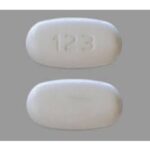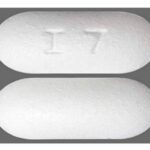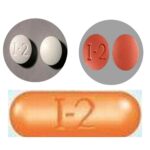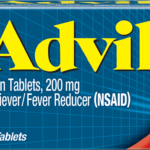What Is G 32 500 Pill Used For?

The orange, capsule-shaped pill with the imprint G 32 500 has been identified as Naproxen 500 mg supplied by Glenmark Generics Inc.. G 32 500 pill belongs to the drug class Nonsteroidal anti-inflammatory drugs and it is used to relieve pain, tenderness, swelling, and stiffness caused by osteoarthritis (arthritis caused by a breakdown of the lining of the joints), rheumatoid arthritis (arthritis caused by swelling of the lining of the joints), juvenile arthritis (a form of joint disease in children), and ankylosing spondylitis (arthritis that mainly affects the spine).
Naproxen works by blocking the enzyme that produces prostaglandins. Prostaglandins play an essential role in inflammation. The body produces them at the site of injured tissue, and they cause redness, heat, swelling, and pain. The body reaches peak levels of G32 pill in 1–4 hours.
How should G 32 pill be used?
The Naproxen is usually taken every 8 hours for gout, and every 6 to 8 hours as needed for pain. If you are taking naproxen on a regular basis, you should take it at the same time(s) every day. Follow the directions on the package or prescription label carefully, and ask your doctor or pharmacist to explain any part you do not understand. Take naproxen exactly as directed. Do not take more or less of it or take it more often than prescribed by your doctor or written on the package.
If you are taking naproxen to relieve the symptoms of arthritis, your symptoms may begin to improve within 1 week. It may take 2 weeks or longer for you to feel the full benefit of the medication. Stop taking nonprescription naproxen and call your doctor if your symptoms get worse, you develop new or unexpected symptoms, the part of your body that was painful becomes red or swollen, your pain lasts for more than 10 days, or your fever lasts for more than 3 days.
What side effects can G 32 pill cause?
G 32 pill may cause side effects. Tell your doctor if any of these symptoms are severe or do not go away:
- constipation
- diarrhea
- gas
- excessive thirst
- headache
- dizziness
- lightheadedness
- drowsiness
- difficulty falling asleep or staying asleep
- burning or tingling in the arms or legs
- cold symptoms
- ringing in the ears
- hearing problems
Some side effects can be serious. If you experience any of the following symptoms call your doctor immediately. Do not take any more naproxen until you speak to your doctor:
- changes in vision
- feeling that the tablet is stuck in your throat
- unexplained weight gain
- shortness of breath or difficulty breathing
- swelling in the abdomen, ankles, feet, or legs
- sore throat, fever, chills, and other signs of infection
- blisters
- rash
- skin reddening
- itching
- hives
- swelling of the eyes, face, lips, tongue, throat, arms, or hands
- difficulty breathing or swallowing
- hoarseness
- excessive tiredness
- pain in the upper right part of the stomach
- nausea
- yellowing of the skin or eyes
- flu-like symptoms
- bruises or purple blotches under the skin
- fast heartbeat
- cloudy, discolored, or bloody urine
- back pain
- difficult or painful urination
- decreased urination
- loss of appetite
- confusion
G 32 pill may cause other side effects. Call your doctor if you have any unusual problems while taking this medication.
G32 Pill Safety Information
People who take nonsteroidal anti-inflammatory drugs like (NSAIDs) (other than aspirin) such as G32 pill may have a higher risk of having a heart attack or a stroke than people who do not take these medications. These events may happen without warning and may cause death. This risk may be higher for people who take NSAIDs for a long time. Do not take an NSAID such as naproxen if you have recently had a heart attack, unless directed to do so by your doctor. Tell your doctor if you or anyone in your family has or has ever had heart disease, a heart attack, or a stroke, if you smoke, and if you have or have ever had high cholesterol, high blood pressure, or diabetes. Get emergency medical help right away if you experience any of the following symptoms: chest pain, shortness of breath, weakness in one part or side of the body, or slurred speech.
If you will be undergoing a coronary artery bypass graft (CABG; a type of heart surgery), you should not take naproxen right before or right after the surgery.
NSAIDs such as G32 pill may cause ulcers, bleeding, or holes in the stomach or intestine. These problems may develop at any time during treatment, may happen without warning symptoms, and may cause death. The risk may be higher for people who take NSAIDs for a long time, are older in age, have poor health, or who drink three or more alcoholic drinks per day while taking naproxen. Tell your doctor if you take any of the following medications: anticoagulants (”blood thinners”) such as warfarin (Coumadin, Jantoven); aspirin; other NSAIDs such as ibuprofen (Advil, Motrin) and ketoprofen; oral steroids such as dexamethasone, methylprednisolone (Medrol), and prednisone (Rayos); selective serotonin reuptake inhibitors (SSRIs) such as citalopram (Celexa), fluoxetine (Prozac, Sarafem, Selfemra, in Symbyax), fluvoxamine (Luvox), paroxetine (Brisdelle, Paxil, Pexeva), and sertraline (Zoloft); or serotonin norepinephrine reuptake inhibitors (SNRIs) such as desvenlafaxine (Khedezla, Pristiq), duloxetine (Cymbalta), and venlafaxine (Effexor XR). Also tell your doctor if you have or have ever had ulcers, bleeding in your stomach or intestines, or other bleeding disorders. If you experience any of the following symptoms, stop taking naproxen and call your doctor: stomach pain, heartburn, vomit that is bloody or looks like coffee grounds, blood in the stool, or black and tarry stools.
Keep all appointments with your doctor and the laboratory. Your doctor will monitor your symptoms carefully and will probably order certain tests to check your body’s response to naproxen. Be sure to tell your doctor how you are feeling so that your doctor can prescribe the right amount of medication to treat your condition with the lowest risk of serious side effects.
Your doctor or pharmacist will give you the manufacturer’s patient information sheet (Medication Guide) when you begin treatment with prescription naproxen and each time you refill your prescription. Read the information carefully and ask your doctor or pharmacist if you have any questions. You can also visit the Food and Drug Administration (FDA) website (http://www.fda.gov/Drugs/DrugSafety/ucm085729.htm) or the manufacturer’s website to obtain the Medication Guide.





